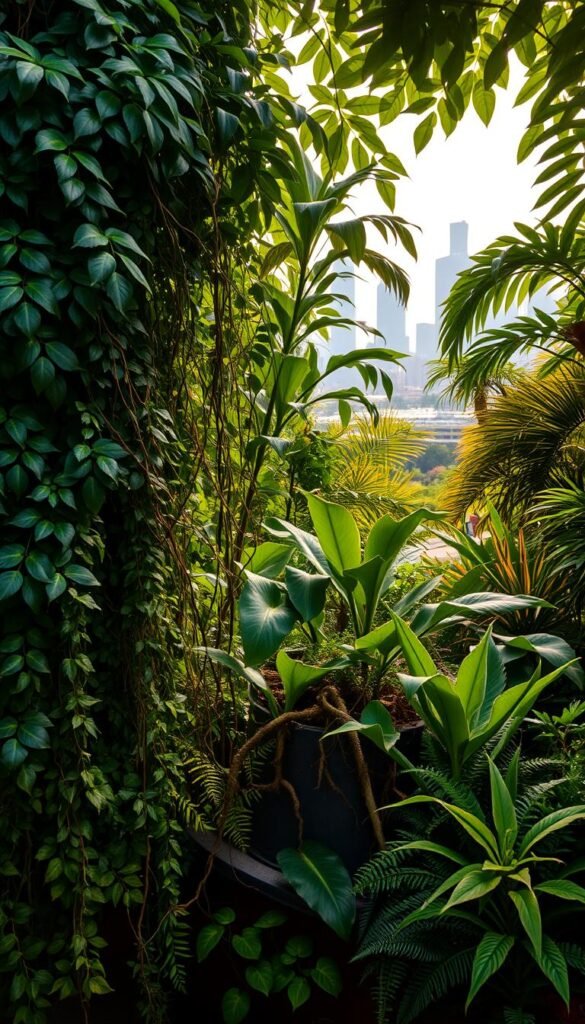Imagine stepping into your own private oasis, where every inch of your patio or balcony bursts with life. With smart planting strategies, even the tiniest outdoor areas can mimic the layered beauty of a tropical rainforest. This approach isn’t just about aesthetics—it’s about transforming limited space into a thriving green retreat.
Designers like Clarke de Mornay suggest grouping plants in clusters of three or five to create harmony. Combine tall tree ferns with mid-sized shrubs and trailing vines for instant depth. Vertical planters or multi-level stands help maximize your footprint, while patio container gardening lets you experiment with movable textures and colors.
San Francisco-based experts prove that mixing broad leaves with delicate foliage adds drama to compact areas. Focus on plants that thrive in your local light conditions—whether sun-loving palms or shade-tolerant ferns. The result? A lush hideaway that feels larger than its square footage.
Ready to turn your concrete corner into a vibrant escape? Let’s explore how strategic layering can make your garden feel wild yet intentional, blending function with jungle-inspired flair.
Setting the Stage for a Lush Urban Oasis
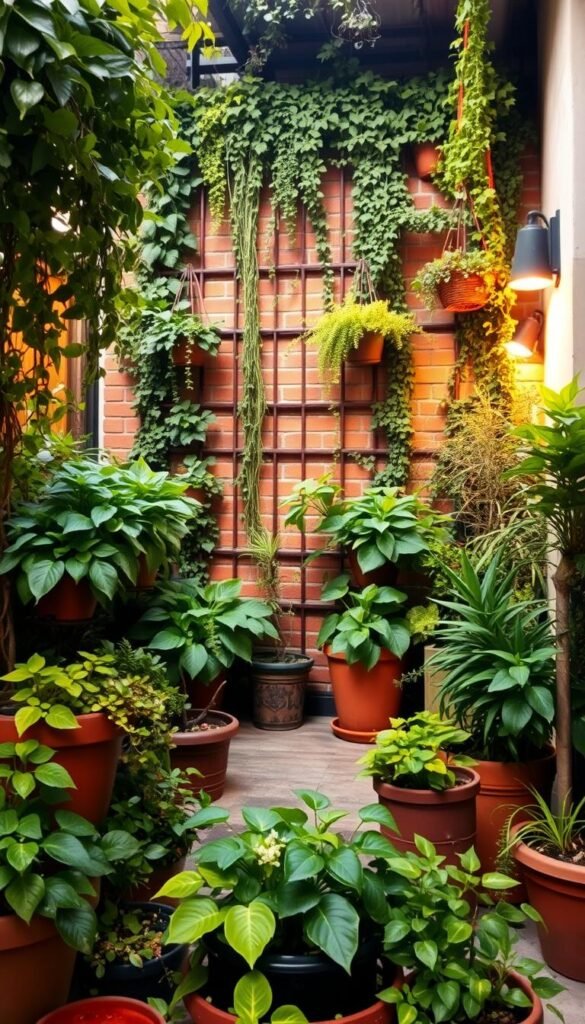
Transforming cramped city corners into vibrant green escapes starts with smart planning. Whether you’re working with a narrow balcony or a postage-stamp patio, understanding your space unlocks endless possibilities for lush growth.
Understanding Small Urban Spaces
Limited square footage doesn’t mean limited impact. Designers in San Francisco use vertical planters and hanging ferns to turn fire escapes into cascading gardens. Key challenges like uneven light or wind exposure become opportunities when you map your area’s microclimate first.
| Challenge | Solution | Example Plants |
|---|---|---|
| Low sunlight | Shade-tolerant shrubs | Hostas, Calatheas |
| Limited ground space | Tiered plant stands | Trailing pothos, Spider plants |
| Harsh winds | Windbreak screens | Dwarf palms, Bamboo |
Benefits of Container Gardening
Pots and planters give you control over soil quality and placement. UK gardeners often rotate citrus trees indoors during winter, then back to patios in summer. This flexibility helps tropical species thrive despite unpredictable weather.
Three key advantages make containers ideal:
- Rearrange layouts for seasonal sun patterns
- Prevent invasive roots from damaging structures
- Simplify pest management through isolation
From London loft terraces to Brooklyn rooftops, mobile gardens prove even concrete jungles can host thriving foliage. Start by sketching your area’s dimensions and light zones—your roadmap to a personalized oasis.
Choosing the Right Plants for Your Jungle Setup
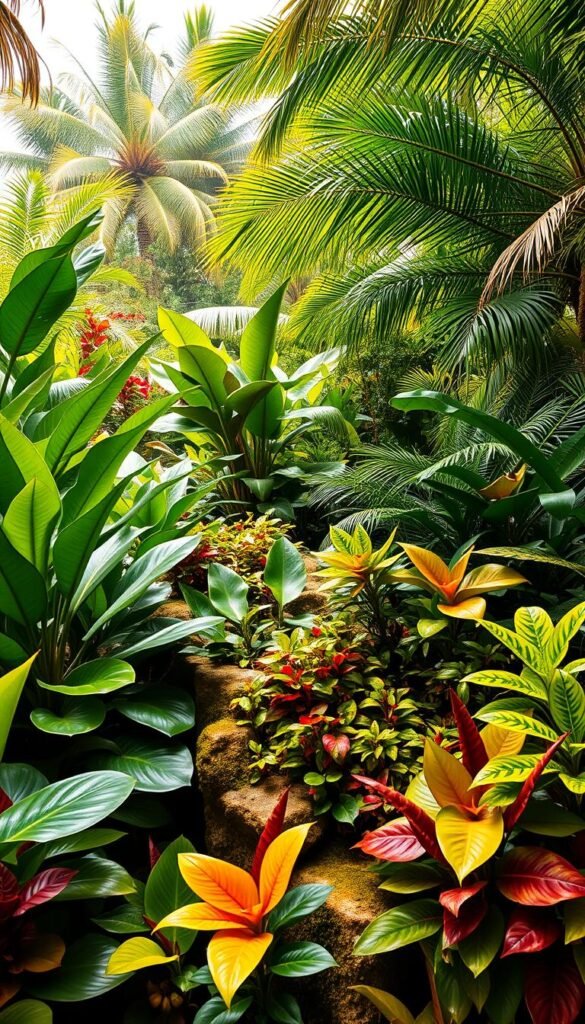
Curating your plant collection transforms tight spaces into vibrant ecosystems. The secret? Pairing showstoppers like tree ferns with practical performers that thrive in your unique conditions. Let’s dig into building a balanced roster of jungle plants that deliver drama without demanding constant attention.
Selecting Foliage, Flowers, and Exotic Greenery
Mix bold textures and delicate details for instant intrigue. Broad-leafed ficuses create lush backdrops, while orchids add pops of color. Urban designers swear by these combos:
- Trailing pothos to soften edges of pots
- Variegated calatheas for patterned foliage
- Bird of paradise as focal points
Philip Oostenbrink’s The Jungle Garden recommends dwarf palms for height without overcrowding. For container-specific ideas, look to succulents like snake plants—they handle neglect like champs.
Matching Plants to Light and Water Conditions
Your garden’s success hinges on reading its microclimate. North-facing balcony? Try shade-loving ferns. Sunny fire escape? Yuccas thrive there. Use this cheat sheet:
| Light Level | Water Needs | Top Picks |
|---|---|---|
| Low | Weekly | ZZ plant, Peace lily |
| Medium | Bi-weekly | Rubber plant, Philodendron |
| Bright | Frequent | Banana tree, Hibiscus |
Pro tip: Group plants with similar thirst levels. It prevents overwatering disasters and keeps your exotic garden thriving year-round.
Mastering Urban Container Gardening Techniques
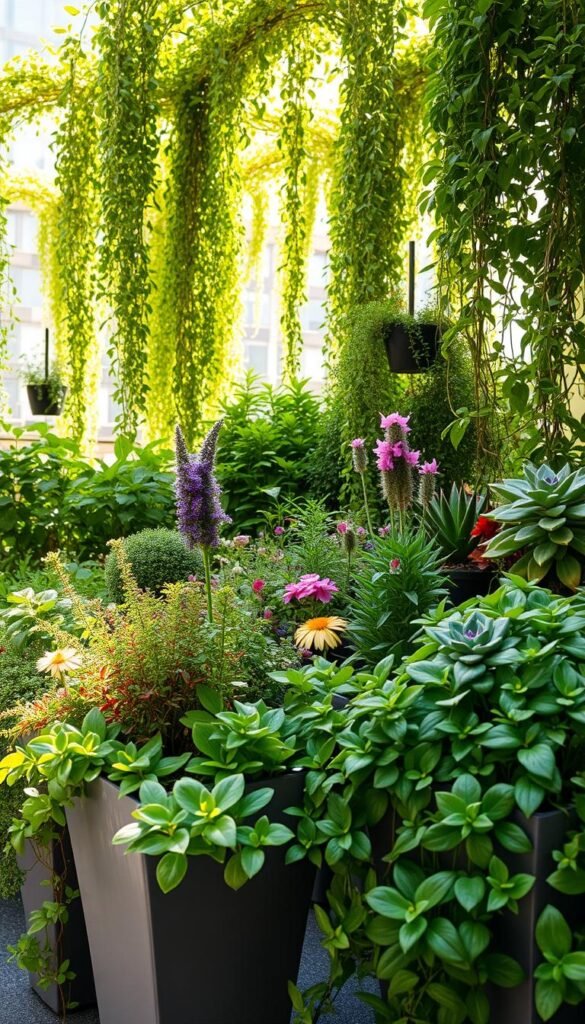
Elevate your compact outdoor area with clever container strategies that turn limitations into design opportunities. Urban gardeners across New York and Chicago use inventive methods to craft layered greenery that feels expansive yet manageable.
Maximizing Limited Space with Innovative Arrangements
Stack pots vertically using staggered shelves or cascading wall planters. A three-tier stand could host a dwarf citrus tree on top, trailing ivy below, and shade-loving shrubs at ground level. Trellises double as living walls—train climbing philodendrons or passionflowers to grow upward instead of outward.
Try these space-saving hacks:
- Hang herb baskets from balcony railings
- Use window boxes for shallow-rooted foliage
- Place narrow trough planters along walkways
Strategic Grouping for Visual Impact
Cluster plants in odd numbers for natural appeal. Position tall snake plants behind mid-height calatheas, with creeping thyme spilling over pot edges. Landscape designer Clarke de Mornay suggests “thinking in thirds”—one-third thriller plants, one-third fillers, and one-third spillers.
| Space Type | Grouping Strategy | Plant Combo |
|---|---|---|
| Narrow balcony | Vertical layers | Bird of paradise, ferns, trailing pothos |
| Sunny patio | Color blocks | Red hibiscus, purple sage, golden sedum |
| Shaded corner | Texture mix | Hostas, begonias, Japanese forest grass |
Rotate containers seasonally to maintain interest—swap spring bulbs for summer blooms, then autumn grasses. This approach keeps your garden dynamic while working within fixed square footage.
Step-by-Step Guide: Creating a Jungle Effect: Layering Plants in Small Urban Gardens
Transform your compact outdoor area into a multi-level paradise using nature’s blueprint. Start by visualizing your space as a miniature ecosystem where every plant plays a specific role in creating depth and drama.
Three-Tier Planting Formula
Begin with tall specimens to form your green ceiling. A fiddle-leaf fig or dwarf palm adds instant height. Surround it with bushy plants like philodendrons for mid-level fullness. Finish with ground-hugging varieties—creeping fig or peperomia—to conceal container edges.
| Layer Type | Purpose | Plant Examples |
|---|---|---|
| Tall (60″+ ) | Creates canopy effect | Bird of paradise, banana tree |
| Medium (12″-36″) | Adds structure | Calathea, snake plant |
| Low (under 12″) | Fills visual gaps | Baby tears, Irish moss |
Sky-High Solutions for Tight Quarters
Turn blank walls into living art with these vertical strategies:
- Mount floating shelves for trailing foliage displays
- Train monstera vines up bamboo trellises
- Hang macramé planters with spider plants
New York gardener Lila Rodriguez transformed her fire escape using staggered plant stands. “Grouping pots at different heights makes my 20 sq ft feel like a secret grove,” she shares. Remember to leave walking space—your garden should feel immersive, not cramped.
Design Ideas for Layered Urban Jungle Gardens
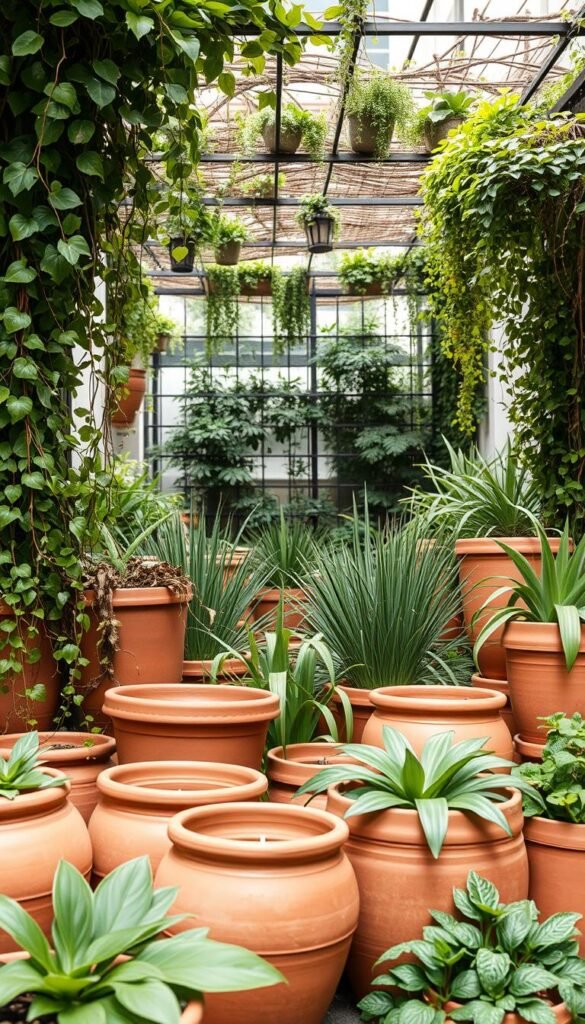
Your balcony becomes a living canvas when pots work together like brushstrokes. Designers Clarke de Mornay and Philip Oostenbrink show how intentional arrangements turn clusters of greenery into artful displays. The secret lies in balancing variety with repetition—letting each planter enhance its neighbors while building visual rhythm.
Blending Pot Colors and Shapes
Think of containers as jewelry for your plants. Matte black pots make neon coleus pop, while terracotta warms up silvery eucalyptus. Try these pairings:
| Pot Style | Best For | Effect |
|---|---|---|
| Glazed ceramics | Tropical foliage | Reflects light |
| Textured concrete | Spiky succulents | Adds grit |
| Curved resin | Trailing vines | Softens edges |
Mix heights for drama—place a tall cylindrical planter behind squat bowls. For choosing containers, consider weight and drainage alongside looks. A cohesive palette (all whites or earth tones) unites mismatched shapes.
Achieving Depth and Cohesion with Repeating Patterns
Repeat elements to guide the eye through your garden. Cluster three identical ferns in staggered pots, or line up hexagonal planters along a railing. Designers use these tricks:
- Alternate round and angular pots in a zigzag
- Echo leaf shapes in container cutouts
- Use one bold color in multiple sizes
Try triangular formations with your tallest plants at the back. This mimics natural growth patterns while maximizing small areas. Remember: patterns don’t need perfection—slightly offset groupings feel more alive.
Seasonal Planting Strategies and Garden Maintenance
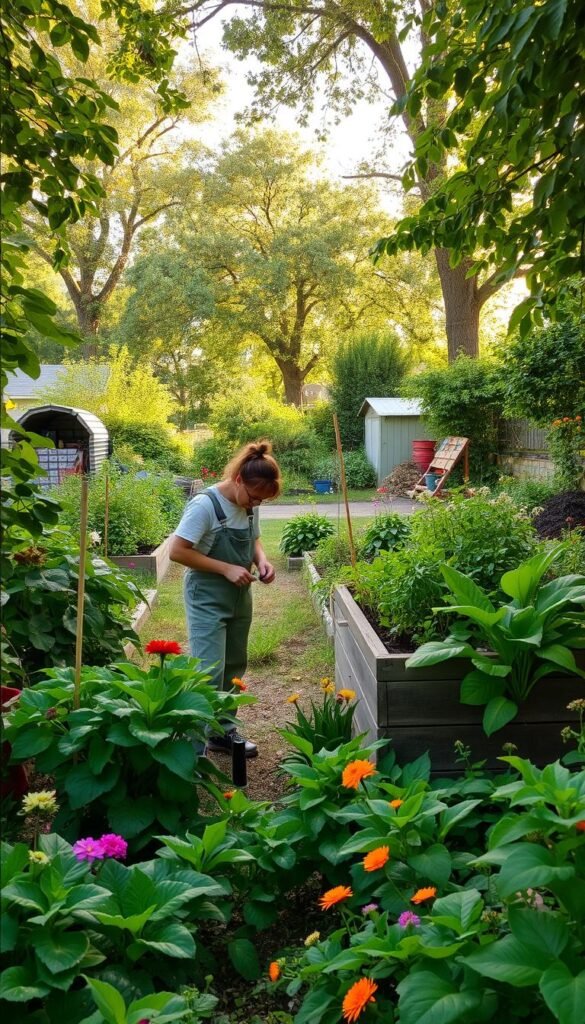
Your green retreat needs tailored care through every season to stay vibrant. Smart adjustments keep plants thriving whether temperatures soar or drop. Let’s explore how to protect your leafy haven year-round.
Adapting to Summer Sun and Winter Conditions
Beat the heat by moving potted plants to morning sun zones. Use shade cloth for delicate foliage during midday scorchers. In winter, wrap tropical species in burlap or bring them indoors before frost hits.
| Season | Challenge | Solution |
|---|---|---|
| Summer | Leaf scorch | Drip irrigation + mulch |
| Winter | Root freeze | Insulated pots + windbreaks |
Watering, Fertilizing, and Pruning Essentials
Group plants by thirst levels—succulents with succulents, ferns with ferns. Feed container gardens monthly in growing season with slow-release granules. Snip dead leaves weekly to prevent disease spread.
Brooklyn gardener Mia Chen shares: “I use chopsticks to aerate soil in tight pots every spring. It boosts drainage better than repotting.” Track growth cycles—pause fertilizing when days shorten, and prune strategically to maintain your jungle garden’s shape.
Integrating Water Features and Ambient Lighting
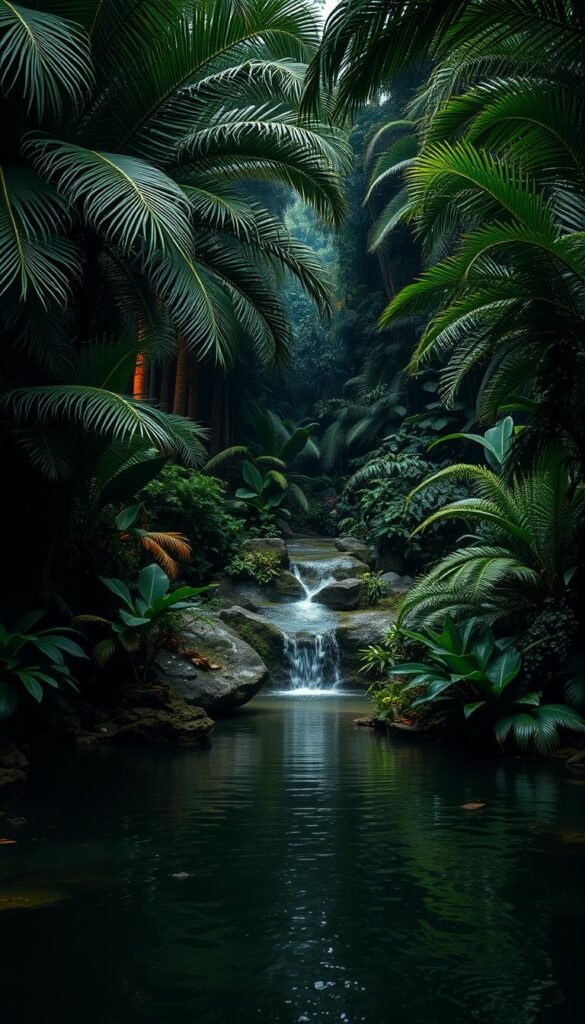
Transform your green space into a sensory retreat by blending movement and light. The gentle trickle of water paired with strategic illumination turns compact areas into immersive escapes. These elements work together to elevate your garden from ordinary to extraordinary, day and night.
Selecting a Water Element for a Tropical Atmosphere
Even small water features create big impact. A tabletop fountain adds soothing sounds without hogging floor space. For vertical solutions, try wall-mounted cascades that flow into hidden reservoirs. Urban designers often use these three options:
| Feature | Space Needed | Maintenance |
|---|---|---|
| Recirculating fountain | 2 sq ft | Monthly cleaning |
| Self-contained pond | 4 sq ft | Seasonal algae control |
| Misting system | Wall-mounted | Weekly filter checks |
Position water elements near seating areas to amplify their calming effect. Pair them with moisture-loving plants like elephant ears or papyrus for a cohesive jungle garden look.
Creating Night Glow to Highlight Foliage
Soft lighting makes broad leaves glow after sunset. Use warm LED strips under benches to uplight ferns, or hang solar lanterns in dwarf palms. Avoid bright white lights—they flatten textures instead of enhancing them.
Try these placement tricks:
- Angle spotlights to cast leaf shadows on walls
- Bury waterproof fixtures along stepping stones
- Drape fairy lights through trailing vines
Chicago gardener Marco Torres shares: “My bamboo fountain’s LED lights make water droplets sparkle like fireflies.” Remember—lighting should guide the eye, not overwhelm. Layer different intensities to keep your plants the star attraction.
Enhancing Biodiversity and Attracting Urban Wildlife
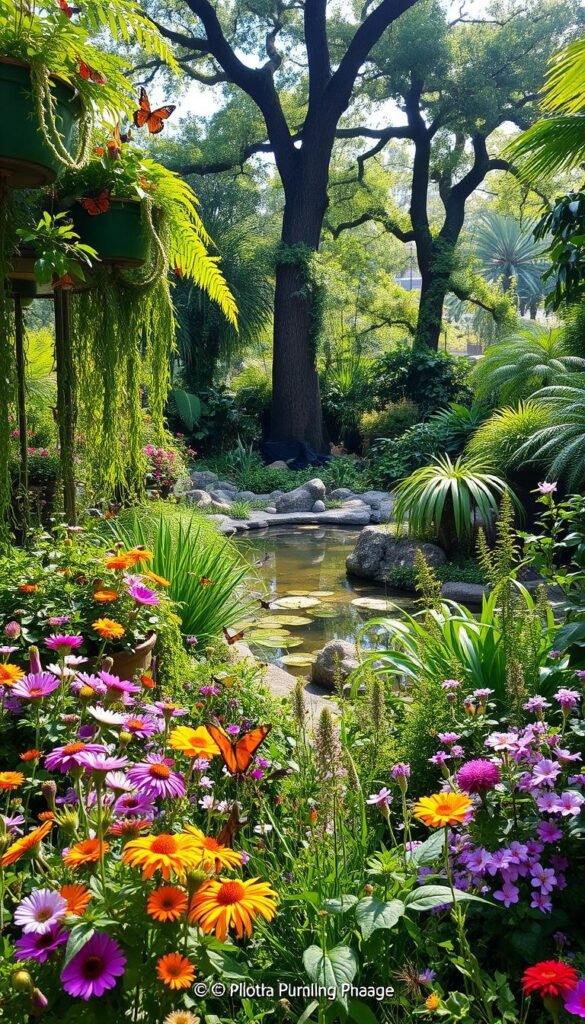
Turn your balcony into a bustling ecosystem by welcoming nature’s helpers. A thriving garden does more than look pretty—it becomes a vital pitstop for pollinators, birds, and beneficial insects. With smart plant choices, even compact spaces can host lively interactions between species.
Choosing Plants that Invite Pollinators and Birds
Native species work overtime in small spaces. Purple coneflowers and bee balm lure butterflies, while sunflowers feed finches. For vertical jungle gardens, try trumpet vines—their tubular flowers attract hummingbirds. Cluster these with low-maintenance blooms like zinnias for continuous nectar.
| Visitor | Preferred Plants | Season |
|---|---|---|
| Bees | Lavender, Salvia | Spring-Fall |
| Butterflies | Milkweed, Lantana | Summer |
| Birds | Serviceberry, Elderberry | Year-round |
Natural Insect-Repelling Strategies
Deter pests without chemicals using aromatic plants. Marigolds repel aphids, while mint confuses cabbage moths. Boston gardener Elena Park uses lemongrass near seating areas: “Its citrus scent keeps mosquitoes away better than sprays.”
Mix these into your jungle garden layout:
- Basil between tomato plants to block whiteflies
- Chrysanthemums along edges for natural pyrethrum
- Garlic chives near roses to deter Japanese beetles
Diverse plantings create checks and balances. Ladybugs feast on aphids in flower-rich yards, while birds snack on caterpillars. Your green corner becomes a self-regulating habitat—wildlife included.
Personalizing Your Urban Jungle Garden Style
Your garden should feel like an extension of your home—a space where your personality blossoms alongside your plants. Start by identifying what excites you: bold geometric patterns, wild cottage charm, or minimalist modern lines. Landscape designer Anaïs Laurent suggests, “Let your favorite room indoors inspire your outdoor style—match colors or repeat textures for harmony.”
Infusing Your Unique Taste into the Design
Mix unexpected elements to create visual storytelling. A Brooklyn gardener paired vintage teacups with air plants on floating shelves, while a Seattle designer used repurposed ladders as vertical stands for trailing ivy. Try these signature touches:
- Paint pots in your front door’s accent color
- Arrange succulents in geometric patterns
- Use garden sculptures as focal points
Balance trends with timelessness. Portland-based grower Marcus Wei combines Japanese maple trees with neon-colored coleus. “The contrast between delicate leaves and vivid foliage keeps it fresh yet grounded,” he explains. Refer to this cheat sheet for cohesive pairings:
| Design Element | Plant Pairing | Effect |
|---|---|---|
| Color blocking | Purple oxalis + golden pothos | Dramatic contrast |
| Texture mixing | Zebra cactus + velvet calathea | Tactile interest |
| Shape repetition | Round peperomia + spherical pots | Visual rhythm |
Your jungle garden becomes truly yours when every choice reflects what you love. Whether through quirky container selections or intentional color schemes, let your space tell your story—one leaf at a time.
Wrapping Up Your Urban Jungle Transformation
Your once-empty balcony now hums with life, a testament to thoughtful greenery choices. By layering tall plants like palms with mid-sized shrubs and trailing vines, you’ve crafted depth even in tight corners. Remember: strategic container arrangements and seasonal adjustments keep your oasis thriving through heatwaves and frost.
Lighting and water features amplify the magic. Soft LEDs make broad leaves glow at night, while tabletop fountains add soothing sounds. For those refining urban balcony setups, lightweight pots and self-watering systems simplify care without sacrificing style.
Your garden reflects you—whether through color-blocked pots or repurposed decor. Rotate blooms seasonally, protect tender species in winter, and let pollinators flock to native flowers. Every choice, from soil blends to trellis placements, builds a living sanctuary.
Ready to start? Grab that sketchpad, pick your first plant, and watch your concrete nook transform. With each leafy addition, you’re not just gardening—you’re curating a wild, welcoming slice of nature right at home.

